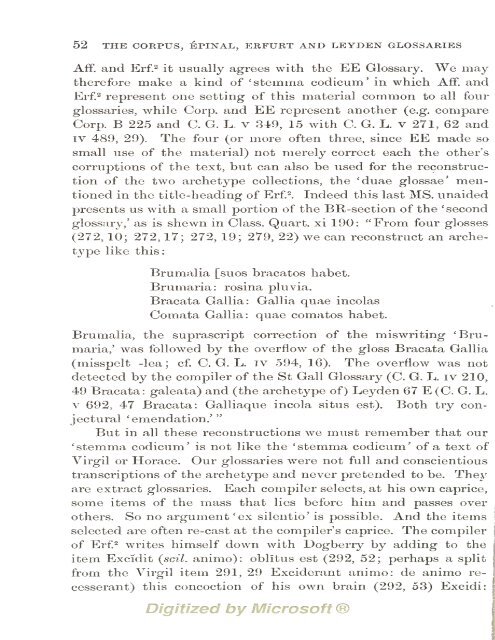the corpus, épinal, erfurt and leyden glossaries, viii - World eBook ...
the corpus, épinal, erfurt and leyden glossaries, viii - World eBook ...
the corpus, épinal, erfurt and leyden glossaries, viii - World eBook ...
You also want an ePaper? Increase the reach of your titles
YUMPU automatically turns print PDFs into web optimized ePapers that Google loves.
52 THE CORPUS, EPINAL, ERFURT AND LEYDEN GLOSSARIES<br />
Aff. <strong>and</strong> Erf.^ it usually agrees with <strong>the</strong> EE Glossary. We may]<br />
'<br />
<strong>the</strong>refore make a kind of 'stemma codicum' in which Aff. <strong>and</strong><br />
Erf.^ represent one setting of this material common to all four<br />
<strong>glossaries</strong>, while Corp. <strong>and</strong> EE represent ano<strong>the</strong>r (e.g. compareJ<br />
Corp. B 225 <strong>and</strong> C. G. L. v 349, 15 with C. G. L. v 271, 62 <strong>and</strong><br />
IV 489, 29). The four (or more often three, since EE made so<br />
small use of <strong>the</strong> material) not merely correct each <strong>the</strong> o<strong>the</strong>r's<br />
corruptions of <strong>the</strong> text, but can also be used for <strong>the</strong> reconstruction<br />
of <strong>the</strong> two archetype collections, <strong>the</strong> 'duae glossae' men-<br />
tioned in <strong>the</strong> title-heading of Erf-. Indeed this last MS. unaided<br />
presents us with a small portion<br />
of <strong>the</strong> BR-section of <strong>the</strong> 'second<br />
glossary,' as is shewn in Class. Quart, xi 190: "From four glosses<br />
(272, 10; 272, 17; 272, 19; 279, 22)<br />
type<br />
like this:<br />
Brumalia [suos bracatos habet.<br />
Brumaria: rosina pluvia.<br />
Bracata Gallia: Gallia quae incolas<br />
Comata Gallia: quae comatos habet.<br />
we can reconstruct an arche-<br />
Brumalia, <strong>the</strong> suprascript correction of <strong>the</strong> miswriting 'Bru-<br />
maria,' was followed by <strong>the</strong> overflow of <strong>the</strong> gloss Bracata Gallia<br />
(misspelt -lea; c£ C. G. L. iv 594, 16). The overflow was not<br />
detected by <strong>the</strong> compiler of <strong>the</strong> St Gall Glossary (C. G. L. iv 210,<br />
49 Bracata: galeata) <strong>and</strong> (<strong>the</strong> archetype of) Leyden 67 E (C.<br />
G. L.<br />
V 692, 47 Bracata: Galliaque incola situs est). Both try con-<br />
jectural 'emendation.'"<br />
But in all <strong>the</strong>se reconstructions we must remember that our<br />
'stemma codicum' is not like <strong>the</strong> 'stemma codicum' of a text of<br />
Virgil or Horace. Our <strong>glossaries</strong><br />
were not full <strong>and</strong> conscientious<br />
transcriptions of <strong>the</strong> archetype <strong>and</strong> never pretended to be. They<br />
are extract <strong>glossaries</strong>. Each compiler selects, at his own caprice, i<br />
some items of <strong>the</strong> mass that lies before him <strong>and</strong> passes over<br />
o<strong>the</strong>rs. So no argument 'ex silentio' is possible. And <strong>the</strong> items<br />
selected are often re-cast at <strong>the</strong> compiler's caprice. The compiler<br />
of Er£2 writes himself down with Dogberry by adding to <strong>the</strong><br />
item Excidit (scil. animo): oblitus est (292, 52; perhaps a split<br />
from <strong>the</strong> Virgil item 291, 29 Exciderant animo: de animo re^<br />
cesserant) this concoction of his own brain (292, 53) Excidi:<br />
'

















